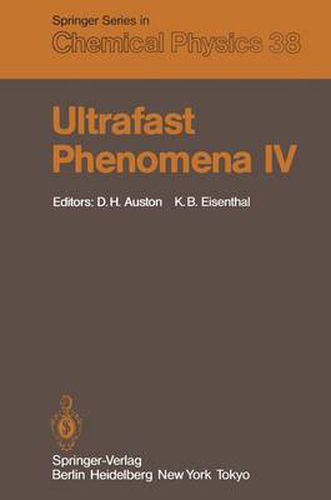Readings Newsletter
Become a Readings Member to make your shopping experience even easier.
Sign in or sign up for free!
You’re not far away from qualifying for FREE standard shipping within Australia
You’ve qualified for FREE standard shipping within Australia
The cart is loading…






This title is printed to order. This book may have been self-published. If so, we cannot guarantee the quality of the content. In the main most books will have gone through the editing process however some may not. We therefore suggest that you be aware of this before ordering this book. If in doubt check either the author or publisher’s details as we are unable to accept any returns unless they are faulty. Please contact us if you have any questions.
The motivating idea of the first Topical Meeting on Picosecond Phenomena, which took place at Hilton Head Island in 1978, was to bring together scien tists and engineers in a congenial setting who were developing picosecond lasers with those who were applying them to problems in chemistry, physics, electronics, and biology. The field has advanced remarkably in the following six years. This is reflected in the size of the conference which has more than doubled in the past six years and now includes scientists from many countries around the world. As evidenced by the papers in this volume, the appl ication of ultrafast 1 ight pulses continues to grow in new and diverse directions encompassing an increasingly wide range of subject areas. This progress has gone hand-in-hand with the development of new and more precise methods of generating and measuring ultrafast light pulses, which now extend well into the femtosecond time domain. It was this latter advance which was responsible for changing the name of the conference to Ultrafast Phenomena. The 1984 meeting was held at the Monterey Conference Center in Monterey, Cal ifornia from June 11 to 15 under the sponsorship of the Optical Society of America. A total of 320 registered participants, including 65 students, attended the three and one-half day conference. The overall enthusiasm of the participants, the high quality of the research presented, and ambiance of the setting combined to produce a successful and enjoyable conference.
$9.00 standard shipping within Australia
FREE standard shipping within Australia for orders over $100.00
Express & International shipping calculated at checkout
This title is printed to order. This book may have been self-published. If so, we cannot guarantee the quality of the content. In the main most books will have gone through the editing process however some may not. We therefore suggest that you be aware of this before ordering this book. If in doubt check either the author or publisher’s details as we are unable to accept any returns unless they are faulty. Please contact us if you have any questions.
The motivating idea of the first Topical Meeting on Picosecond Phenomena, which took place at Hilton Head Island in 1978, was to bring together scien tists and engineers in a congenial setting who were developing picosecond lasers with those who were applying them to problems in chemistry, physics, electronics, and biology. The field has advanced remarkably in the following six years. This is reflected in the size of the conference which has more than doubled in the past six years and now includes scientists from many countries around the world. As evidenced by the papers in this volume, the appl ication of ultrafast 1 ight pulses continues to grow in new and diverse directions encompassing an increasingly wide range of subject areas. This progress has gone hand-in-hand with the development of new and more precise methods of generating and measuring ultrafast light pulses, which now extend well into the femtosecond time domain. It was this latter advance which was responsible for changing the name of the conference to Ultrafast Phenomena. The 1984 meeting was held at the Monterey Conference Center in Monterey, Cal ifornia from June 11 to 15 under the sponsorship of the Optical Society of America. A total of 320 registered participants, including 65 students, attended the three and one-half day conference. The overall enthusiasm of the participants, the high quality of the research presented, and ambiance of the setting combined to produce a successful and enjoyable conference.